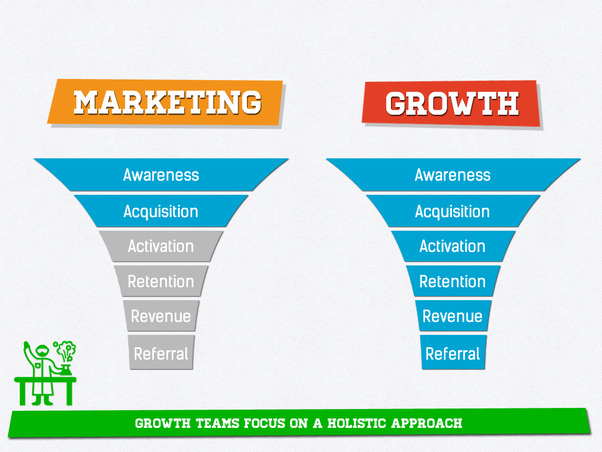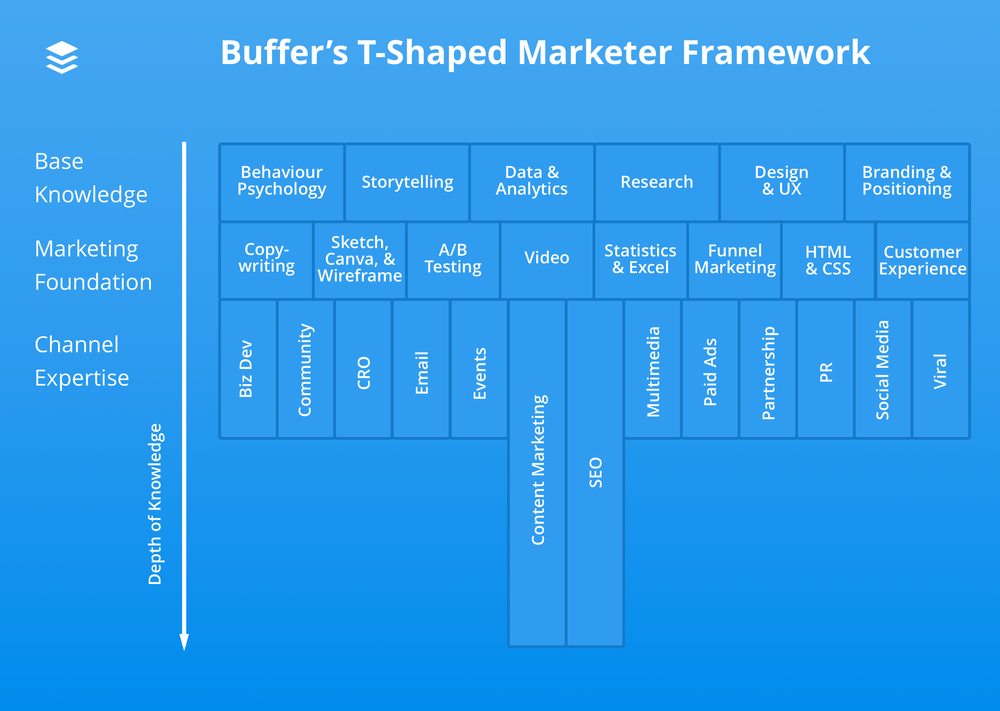As I’ve explained in previous blog posts, I come to marketing not from a traditional marketing background, but from product development and engineering. When I first showed up in marketing, I was as baffled as many of you might be by all the different roles in B2B marketing, and wish I’d had a primer to explain what all the different roles in marketing are.
This is that document. I hope it’s a handy guide for folks outside of the marketing department who need to interact with it. It’s also helpful for startups to understand what kinds of marketing they need right now and what types of people they should be interviewing.
The Purpose of the Marketing Department
“Half the money I spend on advertising is wasted; the trouble is I don’t know which half.”
– John Wanamaker (Attributed, 1838-1922)
The modern B2B marketing organization has one goal and one goal only: revenue generation. Hence it should more accurately be called the Revenue Marketing Department. It may seem obvious that this should be the case, but quite frankly, many previous generations of marketing departments were more concerned with fonts and colors rather than creating outcomes for the company. Hence Wanamaker’s quote from over a century ago, and exactly the issue that a revenue marketing approach seeks to correct.
To play this role, modern B2B marketing departments perform one, possibly two, functions, depending on the structure of the company. First, they deliver qualified leads (MQLs) to the sales team. “Qualified” can be a bit of an imprecise term; I use it to mean, in the BANT model that salespeople know, that there is a strong Need and some Timing urgency. Secondly, and this is applicable only if you have a self-service sales motion: owning the entire process to drive that person to a purchase decision (entering their credit card on your website or something similar). The latter is often synonymous with growth marketing, because by definition a self-service motion is full funnel.

(Credit: Proof Technologies)
This, by the way, is the “funnel” that you hear marketers talking about all the time. If you come from the product development side, it’s the same thing as the pirate metrics concept that Dave McClure coined in 2007 (so named because AAARRR sounds like something a pirate would say). Note that customer acquisition today is not as linear as a funnel would make it out to appear (hence the term “consideration journey” is more in vogue today) but for the purposes of explaining roles, I’ll continue to refer to it.
Roles in Marketing
With those basic concepts addressed, we can now enumerate some of the different teams in B2B marketing departments, relate them to the funnel, and see whether they are full-funnel teams, optimized for a particular part of the funnel, or supporting actors. The roles are not mutually exclusive, and some roles may roll up into another, but as a non-marketing professional, I imagine you want a quick guide to know what these people actually do and how do they relate to the funnel. So, in alphabetical order:
Content Marketing
What do these people do: They create content for all stages of the customer lifecycle to create awareness about the problem set and educate them about your products or solutions. Content can vary quite a bit based on your industry and products, but could include blog posts, white papers, videos, e-books, and the like.
What part of the funnel do they operate in: Full funnel.
Corporate Marketing
What do these people do: Corporate marketing tends to be a very broad umbrella that captures multiple functions. Among them are public relations (writing and issuing press releases, answering press inquiries, pitching stories and media opportunities to the press), analyst relations (briefing industry analysts and maintaining good relationships with them), social media, brand management, graphic design and creative production. Internal communications often roll up under corporate marketing as well. Behind the scenes, corporate marketing ensures that the company identity and positioning is consistent (both visually and in written form), that executives and other spokespersons remain on message, and, of course, when necessary, functions as the last mile in communicating with the public on emergent crises impacting a company.
What part of the funnel do they operate in: Very top of funnel (awareness), although some of the functions in corporate marketing like social media, graphic design/creative production are support functions for other roles in marketing.
Customer Lifecycle Marketing
What do these people do: Create and manage targeted customer communications like e-mail marketing, display ads and retargeting, social media advertising and retargeting, and in organizations where this is still needed, direct mail and telephone contact.
What part of the funnel do they operate in: Top through middle of funnel (through retention).
Customer Marketing
What do these people do: Work with customers and account teams to develop customer stories that can be either referenced publicly (testimonials, quotes, etc.) or used internally by sales teams to articulate benefits and value to prospects.
What part of the funnel do they operate in: Top through mid-funnel.
Demand Generation and Campaigns
What do these people do: Architect campaigns and coordinate activities across a marketing organization in order to achieve some outcome (typically revenue related). The word “campaign” is often used in an imprecise way, both by those in marketing and those outside of it. I like to think of it as having two senses: one is in an evergreen or “always on” sense, for ongoing marketing activities that target core personas that always exist; the second is for defined-timeframe objectives, e.g. “this quarter we want to generate another $1M revenue and we believe we can do it by performing these marketing activities that will cease at the end of the quarter”.
What part of the funnel do they operate in: Top of funnel, sometimes through to activation – it depends on the campaign.
Field Marketing
What do these people do: Organize events or participate in events that will create or accelerate sales pipeline. These events can be as small as executive luncheons all the way through participation in industry conferences or organizing and operating the company’s own conference.
What part of the funnel do they operate in: Primarily top through mid-funnel, although depending on the size of the company and the type of event, their actions could contribute to the bottom of the funnel as well. For example, a company conference can be seen as both driving customer acquisition as well as retention.
Performance Marketing
What do these people do: Performance marketers set up programs for which money is exchanged for performance. This can be anywhere from paid search (where the payment is made up front for delivery of impressions) all the way through affiliate marketing, where a performance marketer would create and manage revenue-sharing programs with marketing/advertising partners, whose compensation comes from some outcome generated. For example: syndicating content marketing’s work in a platform like Intentsify, where content partners are paid based on some defined action (e.g. a persona you want to target downloads the content).
What part of the funnel do they operate in: Top through mid-funnel depending on the activity (marketing via influencer relationships would be top of funnel, while affiliate programs are often drive activation.)
What about Product Marketing?
You’ll notice that I left product marketing out of this list. Why? Because I first want to make a point about all of these marketing roles that’s going to sound pejorative, but it’s not: most marketers do not have very much domain knowledge or product expertise about the thing they are marketing. The curricula in academic marketing programs tends to be of a generalist nature – and often extremely B2C focused because it’s easier for students to grasp.

You don’t have to take my word for it: have a look at Buffer’s T-shaped marketer’s framework. The only marketing roles that remotely come close to having domain expertise are content marketing. (Based on my professional experience, I actually disagree with Buffer’s opinion that SEO folks have much domain expertise.)
In my interactions with the rest of the marketing organization, they have product and domain knowledge they’ve picked up over time, but still need a lot of assistance to deliver marketing messages that are accurate and speak to the target personas. That’s where product marketing comes in: as a translation layer between product management and the product development organization as a whole, and the go-to-market side, i.e. marketing and sales. It is therefore common for product marketing to not be part of the Chief Marketing Officer (CMO) organization at all, but report into the Chief Product Officer’s hierarchy. (Another reason for this reporting line: product marketing also plays another important role, to drive a market-facing orientation in product management so they don’t get myopia about current customers.)
Finally, you may also hear the term solutions marketing, which I regard as adjacent to product marketing. “Solutions” is another ambiguous word used very imprecisely in B2B marketing. I define a solution as a combination of product features and other services / information a company might provide in order to solve a problem that a customer is shopping for, in their language. For instance, a CTO may be struggling with agile transformation and if you are a company like GitHub, the complete solution you provide is not just the product itself, but their customer journey and what features they will use when, professional services, training/collateral, and so on. The other way that the term “solution” is used is to denote a company’s product line applicability to industry verticals. So, for example, a solutions marketer will define the company’s messaging for target verticals and orchestrate activities across other groups in marketing (e.g. content marketing to produce industry-specific content; demand generation to run industry-specific campaigns; etc.) to achieve their objectives.
Measuring Marketing’s Effectiveness
There is one last role that I left out of the foregoing and that is of marketing operations, because these individuals do not create work products that customers see. Instead, these folks create reports, metrics, and attribution models that tie all of marketing’s activities to sales objectives – pipeline contribution and quality. When marketers talk about the power of data – data that you can now collect from all interactions, or “touches”, with a customer – this is what it is utilized for: in essence, to create good attribution modeling that allows marketing departments to avoid being perceived as simply wasting money (as per Wanamaker’s quote). The attribution model, however, must be credible and well-understood both by marketing and the sales leadership. It’s very easy to lie with data and statistics, and much harder to be believed.
Summing Up (or: Tactics are not Strategy)
Hopefully this article has helped you to understand the many roles that exist in modern B2B marketing and what they do. With data, it’s very easy to measure marketing’s effectiveness (i.e. impact on pipeline and closed business) and hold them accountable to their activities. Bear in mind, though, that I have described roles here that are very tactical, and tactics are not a substitute for a go-to-market strategy, which is developed cross-functionally in a company with the CMO being a key stakeholder – but not the only stakeholder. All the execution tactics explained here do not on their own drive desired business outcomes if they are not aligned to corporate and market strategy.
Many thanks to my friend Jen Burke for her review of this blog post.